 Livre numéro 223
Livre numéro 223
 | | History and coin finds in Armenia, Inventory of coins and hoards (7-19th c.) Volume II |
| Titre : | History and coin finds in Armenia, Inventory of coins and hoards (7-19th c.) Volume II / auteur(s) : Georges DEPEYROT - Khatchatur Mousheghian (U), Anahit Mousheghian, Cécile Bresc, Georges Depeyrot, François Gurnet |
|---|
| Editeur : | Moneta |
|---|
| Année : | 2003 |
|---|
| Imprimeur/Fabricant : | |
|---|
| Description : | 136 pages, cartes, graphiques, 8 planches de photographies |
|---|
| Collection : | Collection MONETA, numéro 35 |
|---|
| Notes : | Textes en anglais |
|---|
| Autres auteurs : | |
|---|
| Sujets : | Monnaies, Arménie, Antiquité |
|---|
| ISBN : | 9789080661660 |
|---|
| Bibliothèques : | Catalogué à la Bibliothèque Nationale de France |
|---|
| Prix : | 50 euros |
|---|
Commentaire :Study of coin finds and hoards from Armenia with inventory and catalogue of issues and finds from the 6th century to the 19th century. This new series of Armenian finds will include three volumes. In this volume are catalogued the coins from the last marzes of Armenia, Yerevan and from Mountainous Karabargh. A general introduction presents the question of the issues of Yerevan mint. The book contents maps and graphics, and is illustrated with 8 plates of photos. Khatchatur Mousheghian was director of the Coin Cabinet of Yerevan
Anahit Mousheghian is researcher, Institute of History, Yerevan
Cécile Bresc is specialist of Islamic coinage
Georges Depeyrot is researcher, Centre National de la Recherche Scientifique
Francois Gurnet is specialist of Sasanian coinage. |
Livre numéro 222
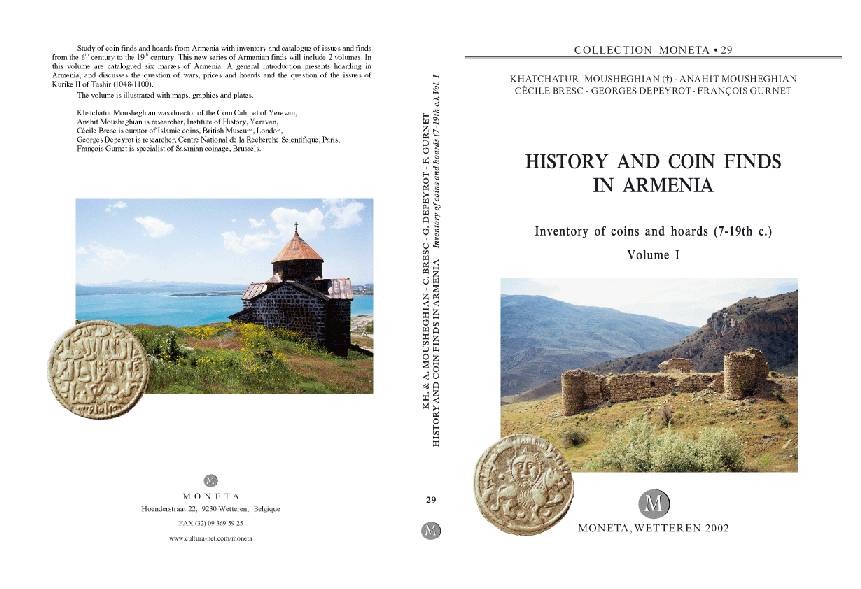 | | History and coin finds in Armenia, Inventory of coins and hoards (7-19th c.) Volume I |
| Titre : | History and coin finds in Armenia, Inventory of coins and hoards (7-19th c.) Volume I / auteur(s) : Georges DEPEYROT - Khatchatur Mousheghian (U), Anahit Mousheghian, Cécile Bresc, Georges Depeyrot, François Gurnet |
|---|
| Editeur : | Moneta |
|---|
| Année : | 2003 |
|---|
| Imprimeur/Fabricant : | |
|---|
| Description : | 192 pages, cartes, graphiques, 21 planches de photographies |
|---|
| Collection : | Collection MONETA, numéro 29 |
|---|
| Notes : | Textes en anglais |
|---|
| Autres auteurs : | |
|---|
| Sujets : | Monnaies, Arménie, Antiquité |
|---|
| ISBN : | 9789080661660 |
|---|
| Bibliothèques : | Catalogué à la Bibliothèque Nationale de France |
|---|
| Prix : | 70 euros |
|---|
Commentaire :Study of coin finds and hoards from Armenia with inventory and catalogue of issues and finds from the 6th century to the 19th century. This new series of Armenian finds will include 2 volumes. In this volume are catalogued six marzes of Armenia. A general introduction presents hoarding in Armenia, and discusses the question of wars, prices and hoards and the question of the issues of Kurike II of Tashir (1048-1100). The book contents maps and graphics, and is illustrated with 21 plates of photos. Khatchatur Mousheghian was director of the Coin Cabinet of Yerevan
Anahit Mousheghian is researcher, Institute of History, Yerevan
Cécile Bresc is specialist of Islamic coinage
Georges Depeyrot is researcher, Centre National de la Recherche Scientifique
Francois Gurnet is specialist of Sasanian coinage. |
Livre numéro 221
 | | History and coin finds in Armenia, Coins from Ani, Capital Of Armenia (4th c. BC - 19th c. AD) |
| Titre : | History and coin finds in Armenia, Coins from Ani, Capital Of Armenia (4th c. BC - 19th c. AD) / auteur(s) : Georges DEPEYROT - Khatchatur Mousheghian (U), Anahit Mousheghian, Cécile Bresc, Georges Depeyrot, François Gurnet |
|---|
| Editeur : | Moneta |
|---|
| Année : | 2001 |
|---|
| Imprimeur/Fabricant : | |
|---|
| Description : | 160 pages, cartes, graphiques, 16 planches de photographies |
|---|
| Collection : | Collection MONETA, numéro 21 |
|---|
| Notes : | Textes en anglais |
|---|
| Autres auteurs : | |
|---|
| Sujets : | Monnaies, Arménie, Antiquité |
|---|
| ISBN : | 9789074623261 |
|---|
| Prix : | 70 euros |
|---|
Commentaire :After Antiquity, Ani became one of the most famous cities in Armenian history. After the Sasanian period, the town became, in the 10th century, the capital of the Armenian Batraguni kingdom. In 961, after several attempts to take Duin (occupied by Islamic armies), king Ashot III proclaimed Ani as the new capital of the whole Armenian kingdom. During the centuries, armies attacked Ani, but the 10-12th centuries were the period of splendor of all the Armenian kingdoms. In 1045, Ani became a Byzantine city but was soon after devastated by Alp Arslan and occupied by Shaddadids. In 1236, Jalal al-Din and the Mongols devastated Ani. It was the beginning of the decline of the city. Nearly 2.000 coins and 12 hoards were found in Ani. The most important part was Byzantine bronze coins sometimes with countermarks and Islamic coins. The book contents maps and graphics, and is illustrated with 16 plates of photos. Khatchatur Mousheghian was director of the Coin Cabinet of Yerevan
Anahit Mousheghian is researcher, Institute of History, Yerevan
Cécile Bresc is specialist of Islamic coinage
Georges Depeyrot is researcher, Centre National de la Recherche Scientifique
Francois Gurnet is specialist of Sasanian coinage. |
Livre numéro 220
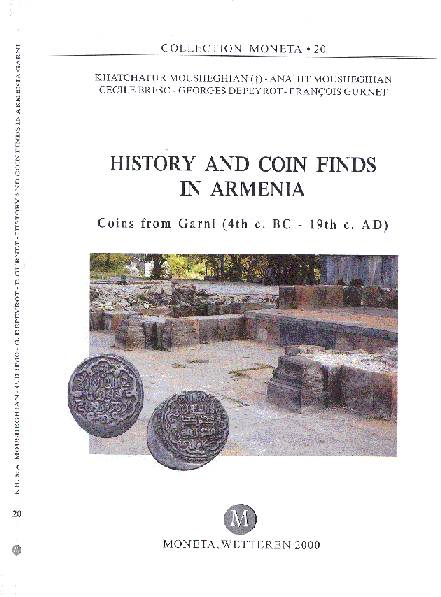 | | History and coin finds in Armenia, Coins from Garni (4th c. BC - 19th c. AD) |
| Titre : | History and coin finds in Armenia, Coins from Garni (4th c. BC - 19th c. AD) / auteur(s) : Georges DEPEYROT - Khatchatur Mousheghian (U), Anahit Mousheghian, Cécile Bresc, Georges Depeyrot, François Gurnet |
|---|
| Editeur : | Moneta |
|---|
| Année : | 2001 |
|---|
| Imprimeur/Fabricant : | |
|---|
| Description : | |
|---|
| Collection : | Collection MONETA, numéro 20 |
|---|
| Notes : | Textes en anglais |
|---|
| Autres auteurs : | |
|---|
| Sujets : | Monnaies, Arménie, Antiquité |
|---|
| ISBN : | 9789074623254 |
|---|
| Prix : | 50 euros |
|---|
Commentaire :The fortified city of Garni was founded in the 7th century BC. During the Roman period (first half of the 1st century B.C.) it was the residence of the Roman commanders and troops. It was also the king residence during the period of Arshakid dynasty (first half of the 1st century B.C.). The Hellenistic temple was built and the city fortified during the period of Tiridates I (55/66-88). It was a fortress also in the 4th century AD, being the residence of the bishop. In 640; Garni was captured by Arabic troops. During the period of Bagratid dynasty (the beginning of the 10th century) Garni was again strengthened. At the end of the 14th century, Garni was again captured, this time by Tamerlane and later by Ottoman troops. More than 350 coins were found in the site during excavations. Eight hoards were also found, composed of Roman and medieval coins. We publish a total of about 1.000 coins. The book contents maps and graphics, and is illustrated with 8 plates of photos. Khatchatur Mousheghian was director of the Coin Cabinet of Yerevan.
Anahit Mousheghian is researcher, Institute of History, Yerevan.
Cécile Bresc is specialist of Islamic coinage.
Georges Depeyrot is researcher, Centre National de la Recherche Scientifique.
Francois Gurnet is specialist of Sasanian coinage. |
Livre numéro 219
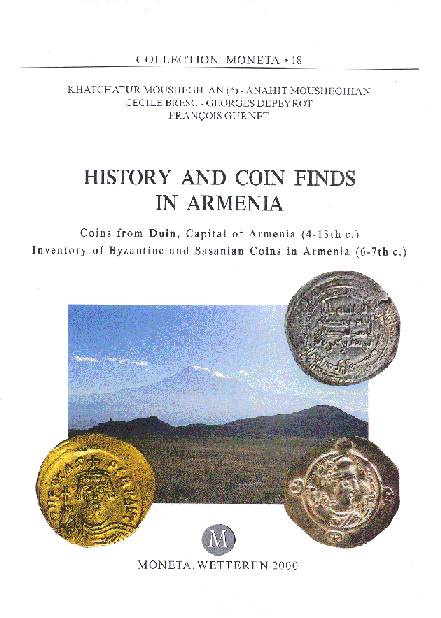 | | History and coin finds in Armenia, Coins from Duin, Capital of Armenia (4-13th c.), Inventory of Byzantine and Sasanian Coins in Armenia (6th-7th c.) |
| Titre : | History and coin finds in Armenia, Coins from Duin, Capital of Armenia (4-13th c.), Inventory of Byzantine and Sasanian Coins in Armenia (6th-7th c.) / auteur(s) : Georges DEPEYROT - Khatchatur Mousheghian (U ), Anahit Mousheghian, Cécile Bresc, Georges Depeyrot, François Gurnet |
|---|
| Editeur : | Moneta |
|---|
| Année : | 2001 |
|---|
| Imprimeur/Fabricant : | |
|---|
| Description : | 216 pages, cartes, graphiques, 32 illustrations |
|---|
| Collection : | Collection MONETA, numéro 18 |
|---|
| Notes : | Textes en anglais |
|---|
| Autres auteurs : | |
|---|
| Sujets : | Monnaies, Arménie, Antiquité |
|---|
| ISBN : | 9789074623230 |
|---|
| Prix : | 75 euros |
|---|
Commentaire :Dvin (Dubios, Dabil, Dwin) was the Capital of Armenia from the 4th century to the 13th century. It was the seat for certain period of the Armenian patriarch (catholicus). Duin was also an economic and industrial center and the place became important in the trade with Central Asia. This city was also involved in the conflicts between Byzantines, Sasanians and Islamics. In 640, the town was conquered by the Muslims and became the seat of the governor during the 9th and 10th centuries. In Duin, mints were active and many bronze and silver coins are signed by the city. More than 5.400 gold, silver and bronze coins were found in Duin: about 1.000 in the excavations and about 4.500 in 15 hoards. The hoards span nearly 8 centuries. The first ones were buried during the Byzantine and Sasanian wars and the last one during the Mongol invasion and destruction of the city. Many hoards were composed of gold Byzantine coins. The inventory of Byzantine and Sasanian coins lists many single finds and hoards. One of them was found in Gumri and composed of Sasanian drachms. Many others contained Byzantine hexagrams. The book contents maps and graphics, and is illustrated with 32 plates of photos and 7 plates of rubbings. Khatchatur Mousheghian was director of the Coin Cabinet of Yerevan.
Anahit Mousheghian is researcher (Institute of History, Academy, Yerevan).
Cécile Bresc is specialist of Islamic coins.
Georges Depeyrot is researcher (Centre national de la Recherche Scientifique, Paris).
François Gurnet is specialist of Sasanian Coins. |
Livre numéro 218
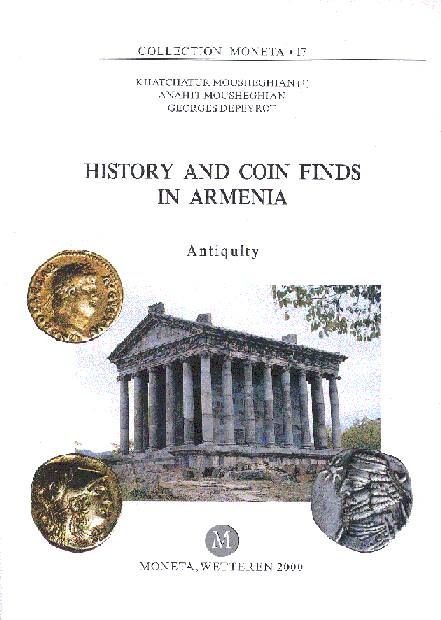 | | History and coin finds in Armenia, Antiquity |
| Titre : | History and coin finds in Armenia, Antiquity / auteur(s) : Georges DEPEYROT - Khatchatur Mousheghian (U ), Anahit Mousheghian, Georges Depeyrot |
|---|
| Editeur : | Moneta |
|---|
| Année : | 2000 |
|---|
| Imprimeur/Fabricant : | |
|---|
| Description : | 184 pages, cartes, graphiques, 23 illustrations |
|---|
| Collection : | Collection MONETA, numéro 17 |
|---|
| Notes : | Textes en anglais |
|---|
| Autres auteurs : | |
|---|
| Sujets : | Monnaies, Arménie, Antiquité |
|---|
| ISBN : | 9789074623223 |
|---|
| Prix : | 75 euros |
|---|
Commentaire :Khatchatur Mousheghian prepared a publication of hoards and site finds from Armenia. Completed, with new studies, this documentation is now published. In this book are published catalogues of hoards: Artashat (70 BC and 59 BC); Armenia (55 BC); Artik (45 BC); Parakar (38 BC); Sarnakounk (25 BC); Tovuz (25 BC); Aparan (2 BC); Gurmi and Artashat (1st c. BC); Echmiadzin (175); Garni (192); Oshakan (3rd c.); Yerevan (5th c.). A list of site finds in Armenia (coins from 4th c. BC to 5th c. AD) and a list of Armenian coin finds out of the actual Republic of Armenia are given. Two studies complete the general analysis of coin circulation. One is devoted to hoarding in the first Century BC (with Sarnakounk hoard) and the second is devoted to the study of second Century denarii hoards in the Roman Empire (with Echmiadzin and Garni hoards). These two studies summarize all the new studies about silver coin hoards and give new interpretations of this kind of coin circulation. Khatchatur Mousheghian was director of the Coin Cabinet of Yerevan.
Anahit Mousheghian is researcher (Institute of History, Academy, Yerevan)
Georges Depeyrot is researcher (Centre national de la Recherche Scientifique, Paris) |
Livre numéro 217
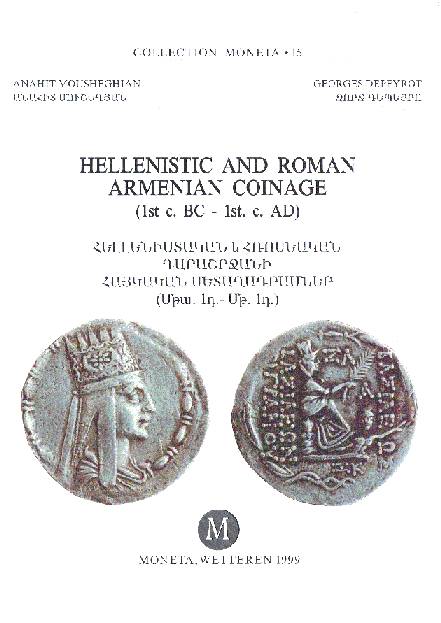 | | Hellenistic and Roman Armenian Coinage (1st c. BC - 1st c. AD) |
| Titre : | Hellenistic and Roman Armenian Coinage (1st c. BC - 1st c. AD) / auteur(s) : Georges DEPEYROT - |
|---|
| Editeur : | Moneta |
|---|
| Année : | 1999 |
|---|
| Imprimeur/Fabricant : | |
|---|
| Description : | 256 pages, 8 illustrations |
|---|
| Collection : | Collection MONETA, numéro 15 |
|---|
| Notes : | Textes en anglais et arménien |
|---|
| Autres auteurs : | |
|---|
| Sujets : | Monnaies, Arménie, Antiquité |
|---|
| ISBN : | 9789074623209 |
|---|
| Prix : | 60 euros |
|---|
Commentaire :During the first Century BC and the beginning of the first Century AD, the Armenian Kingdom struck Silver and Bronze Coinage. The main part of the Coinage was issues of Tigranes II. He began to strike after his invasion of the Seleucid Kingdom and continued his production of coins during and after the war against Lucullus and Pompeius. His successors continued to strike, but the quantities of coins decreased. The last Armenian issues were Roman denarii of the C L CAESARES type. This book presents a new corpus of the Armenian issues of the Hellenistic and Roman periods. More than 2.500 coins are catalogued. A new chronology and a new organization of coinage are presented. The Coinage is attributed to several mints of Syria and Armenia. Text in English and Armenian Anahit Mousheghian is researcher (Institute of History, Academy, Yerevan)
Georges Depeyrot is researcher (Centre national de la Recherche Scientifique, Paris) |
|